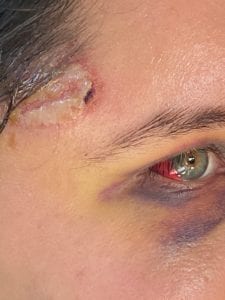At the height of Black Lives Matter protests this spring, Breanna Contreras was marching among the crowds in downtown San Jose when chaos suddenly broke out. People scattered and started running past her in the opposite direction, many with eyes streaming from tear gas. A moment later, Contreras heard “Pop! Pop! Pop!” and felt something slam into her head.
“Oh my gosh, I’ve been shot!” the 21-year-old recalled saying.
Contreras stumbled back, touched her face and saw blood. Her head was throbbing and she felt dizzy. She said the pain was so intense she wondered if she would die. A scar from a rubber bullet serves as a reminder of that day.
“They were shooting like crazy. It was very reckless. There was no need for the protest to be met with such violence,” Contreras said. “Anything the city can do to avoid the situation we had that day is crucial.”


Mayor Sam Liccardo, Vice Mayor Chappie Jones and councilmembers Lan Diep, Magdalena Carrasco and Raul Peralez on June 5 issued a memorandum seeking to amend the city’s use of kinetic impact projectiles (rubber bullets) within dense crowds. Recently, Liccardo said he would not support a motion that did not ban the use of rubber bullets in a crowd but allowed that they could be used to disarm a violent person who wasn’t in a crowd.
On June 16, Police Chief Eddie Garcia modified the police duty manual to prohibit the use of rubber bullets in crowds, except to target someone with a weapon or attacking others.
A City Council vote on completely banning the use of rubber bullets in a crowd was scheduled for Aug. 18 but after some discussion, it was delayed until Sept. 15. Councilmembers wanted more information on alternative crowd control measures from the police chief.
“Immediately following the first weekend of protests, I advocated that SJPD no longer use rubber bullets and bean bag rounds for crowd control purposes,” Peralez said. “I have not advocated that we ban the use of tear gas as I do believe that is an effective and much less impactful tool for crowd control versus the projectile weapons.”
Rubber bullets have caused blindness, broken jaws and brain injuries. Tear gas results in burning pain in the eyes, throat and lungs for 30 minutes or longer and can have lethal effects in high concentrations.
According to National Geographic, when shot at close range, rubber bullets cause damage on par with a car accident as their force can break bones and crush blood vessels, resulting in bleeding in the kidneys, spleens or liver.
A study published in 2017 by medical journal BMJ Open determined 3% of people hit by kinetic projectiles (rubber bullets, beanbags and foam rounds) died from the injury and 15.5% of the 1,984 people studied suffered serious harm such as head, neck, chest and abnominal trauma, bowel and spleen injuries requiring surgery and eye injuries leading to the loss of vision.
“I know the police department believes they can use their discretion in a crowded situation and hit somebody who is violent and attacking somebody and not hurt others,” Liccardo said, “but the evidence I have … in my own city is very much to the contrary. … A well-trained officer cannot control where those bullets go because they ricochet.”
State and county lawmakers also have called for changes in crowd control tactics.
Assemblywoman Lorena Gonzalez (D-San Diego), supported by Assemblymember Ash Kalra (D-San Jose) and legislators from San Francisco and Los Angeles, authored Assembly Bill 66, which calls for a statewide standard on tear gas, chemical agents (pepper spray) and kinetic projectiles.
The bill would prohibit the use of these weapons on peaceful protestors or to facilitate curfews. They could only be fired at a specific target who presents a clear and imminent threat to himself, officers, or others. The bill would also require data collection on any resulting injuries from these weapons.
On Aug. 8, the state Senate Public Safety Committee voted 5 to 1 in favor of the bill. On Aug. 20, the bill passed the Senate Appropriations Committee and now heads to the Senate floor. If it passes the Senate and receives a concurrence vote in the Assembly, the bill will head to the governor.
Contact Lorraine Gabbert at [email protected].



Leave a Reply
You must be logged in to post a comment.